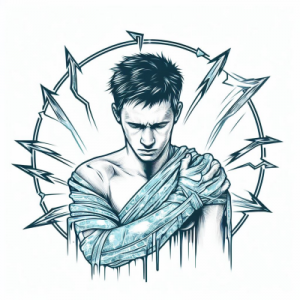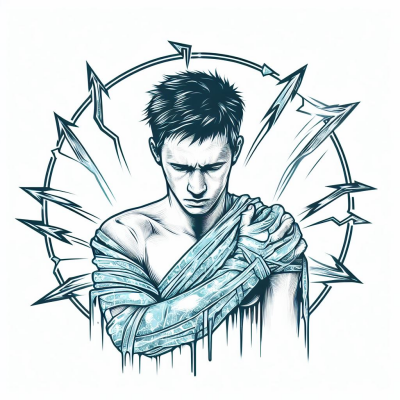You may think that shoulder pain is just a temporary inconvenience, but what if it’s more than that?
Frozen shoulder, a condition that affects the shoulder joint, can cause stiffness, limited mobility, and intense pain.
In this article, we will demystify the causes, symptoms, and solutions of frozen shoulder.
By understanding this condition, you can take proactive steps to prevent and manage it, ensuring a pain-free and mobile shoulder.
Key Takeaways
- Frozen shoulder, also
 known as adhesive capsulitis, is a condition that causes stiffness and restricted movement in the shoulder joint.
known as adhesive capsulitis, is a condition that causes stiffness and restricted movement in the shoulder joint. - The exact cause of frozen shoulder is unknown, but factors like shoulder immobility and certain medical conditions can contribute to its development.
- Symptoms of frozen shoulder include increased pain, loss of range of motion, and stiffness that worsens over time. Diagnosis involves a physical examination and special tests to confirm the condition.
- Treatment options for frozen shoulder include non-surgical approaches like physical therapy and pain medication, as well as surgical intervention in severe cases. Rehabilitation and preventive measures are crucial for recovery and reducing the likelihood of future episodes.
What Is Frozen Shoulder
If you’re experiencing limited movement and pain in your shoulder, you may be dealing with a condition known as frozen shoulder. Frozen shoulder, also known as adhesive capsulitis, is a condition that affects the shoulder joint, causing stiffness and restricted mobility. This condition occurs when the tissues surrounding the shoulder joint become thick and tight, leading to the formation of scar tissue.
The exact cause of frozen shoulder is still unknown, but there are several factors that can contribute to its development. One of the main causes of frozen shoulder is shoulder immobility due to injury or surgery. When the shoulder is immobilized for an extended period, such as after a fracture or rotator cuff tear, the joint capsule can become inflamed and thickened, resulting in frozen shoulder. Other contributing factors include hormonal imbalances, certain medical conditions like diabetes or thyroid disorders, and autoimmune diseases.
Treatment for frozen shoulder focuses on managing pain and restoring shoulder mobility. Non-surgical options include physical therapy, stretching exercises, and pain medication. Physical therapy plays a crucial role in improving shoulder range of motion by gradually stretching the shoulder joint and surrounding tissues. Pain medication, such as nonsteroidal anti-inflammatory drugs (NSAIDs), can help alleviate pain and reduce inflammation.
In more severe cases, where conservative treatments haven’t been successful, surgical intervention may be necessary. Surgery for frozen shoulder involves manipulating the shoulder joint under anesthesia to break up scar tissue and improve range of motion. Following surgery, physical therapy is crucial to regain strength and mobility in the shoulder.
Understanding the Shoulder Joint
To better understand frozen shoulder, it’s important to have a clear understanding of how the shoulder joint functions.
The shoulder joint is a complex structure that allows for a wide range of motion and mobility. Here are some key points to help you grasp the anatomy and mobility of the shoulder:
-
The shoulder joint is made up of three bones: the humerus (upper arm bone), the scapula (shoulder blade), and the clavicle (collarbone). These bones work together to provide stability and support to the joint.
-
The shoulder joint is a ball-and-socket joint, which means that the rounded head of the humerus fits into a shallow socket on the scapula. This design allows for a greater range of motion compared to other joints in the body.
-
The shoulder joint is supported by a network of ligaments, tendons, and muscles. These structures help to stabilize the joint and facilitate movement.
-
Shoulder mobility is essential for everyday activities such as reaching, lifting, and throwing. It allows us to perform tasks with ease and efficiency.
-
With its wide range of motion, the shoulder joint is also prone to injury and conditions like frozen shoulder. When the joint becomes stiff and painful, it can significantly limit mobility and impact daily life.
Understanding the shoulder joint’s anatomy and mobility is crucial in comprehending the causes, symptoms, and treatment options for frozen shoulder. By gaining insight into how this complex joint functions, you can better appreciate the impact frozen shoulder has on your overall well-being.
Primary Causes of Frozen Shoulder
Understanding the primary causes of frozen shoulder can help you identify potential risk factors and take necessary precautions to prevent this condition. Frozen shoulder, also known as adhesive capsulitis, is a condition characterized by stiffness, pain, and limited range of motion in the shoulder joint. While the exact cause of frozen shoulder isn’t fully understood, there are several primary causes that have been identified.
One primary cause of frozen shoulder is inflammation of the shoulder joint lining, also known as synovitis. Inflammation can occur due to an injury, overuse of the shoulder joint, or medical conditions such as arthritis. When the synovium becomes inflamed, it can lead to the formation of scar tissue, which can restrict movement and cause the shoulder joint to become ‘frozen’.
Another primary cause of frozen shoulder is the thickening and tightening of the shoulder joint capsule. The capsule is a connective tissue that surrounds the shoulder joint and helps to hold it together. When the capsule becomes thickened and tight, it can limit the movement of the joint and result in frozen shoulder.
Understanding the primary causes of frozen shoulder can also involve considering risk factors. Factors such as age, gender, and certain medical conditions can increase the likelihood of developing frozen shoulder. For example, people over the age of 40, women, and those with diabetes or thyroid disorders are more prone to developing this condition.
Secondary Causes of Frozen Shoulder
To fully understand the causes of frozen shoulder and how to prevent it, it’s important for you to be aware of the secondary causes as well. While primary causes are typically related to inflammation and thickening of the shoulder capsule, secondary causes can arise from various underlying conditions or factors. Here are some secondary causes of frozen shoulder that you should know about:
-
Trauma or Injury: A shoulder injury, such as a fracture or dislocation, can lead to the development of frozen shoulder. The immobility and lack of movement during the healing process can contribute to the condition.
-
Diabetes: Individuals with diabetes are at a higher risk of developing frozen shoulder. The exact reason behind this association isn’t fully understood, but it’s believed to be related to the effects of high blood sugar levels on the connective tissues in the shoulder joint.
-
Immobilization: Prolonged immobilization of the shoulder joint, whether due to surgery, casting, or wearing a sling, can result in frozen shoulder. Lack of movement and stretching can cause the shoulder capsule to become stiff and tight.
When it comes to treating frozen shoulder caused by secondary factors, the focus is on addressing the underlying condition or factor. For example, if diabetes is the secondary cause, managing blood sugar levels through medication, diet, and exercise can help alleviate symptoms. Physical therapy, stretching exercises, and anti-inflammatory medications may also be recommended to improve joint mobility and reduce pain.
Recognizing the Early Symptoms
Are you experiencing any early symptoms of frozen shoulder? It’s important to recognize these symptoms early on and seek medical advice for proper diagnosis and treatment.
Frozen shoulder, also known as adhesive capsulitis, is a condition characterized by stiffness and pain in the shoulder joint. In the early stages, you may notice a gradual loss of range of motion in your shoulder. It may become difficult to perform simple tasks such as reaching behind your back or lifting objects overhead. The pain can also be persistent, especially at night, and may worsen with movement. These early symptoms shouldn’t be ignored as they can indicate the onset of frozen shoulder.
If you’re experiencing any of these early symptoms, it’s recommended to seek medical advice. A healthcare professional, such as a primary care physician or an orthopedic specialist, can evaluate your symptoms and provide an accurate diagnosis. They’ll conduct a physical examination of your shoulder and may order imaging tests such as X-rays or MRI to rule out other potential causes of your symptoms.
Recognizing the early symptoms of frozen shoulder is crucial because early intervention can lead to better outcomes. Treatment options for frozen shoulder may include physical therapy, pain management techniques, and in some cases, corticosteroid injections or surgical intervention. Your healthcare provider will develop a treatment plan tailored to your specific needs.
Progression of Symptoms
As you continue to experience early symptoms of frozen shoulder, the stiffness and pain in your shoulder joint may gradually worsen over time. It’s important to understand the progression of symptoms in order to seek appropriate treatment options.
Here are some important points to consider:
-
Increased pain: As the condition progresses, you may notice an increase in the intensity of pain in your shoulder joint. Initially, the pain may be mild and only present during certain movements. However, as the frozen shoulder develops, the pain can become more constant and severe, even affecting your sleep.
-
Loss of range of motion: Another symptom that may worsen over time is the loss of range of motion in your shoulder. Initially, you may experience difficulty in performing certain movements, such as reaching behind your back or lifting your arm overhead. As the condition progresses, the range of motion in your shoulder can become significantly limited, making it challenging to perform everyday activities.
-
Stiffness: One of the hallmark symptoms of frozen shoulder is stiffness in the shoulder joint. At first, you may notice a mild stiffness that improves with movement. However, as the condition advances, the stiffness can become more pronounced and persistent, affecting your ability to move your shoulder freely.
It is important to seek medical attention if you notice the progression of these symptoms. Your healthcare provider can recommend appropriate treatment options, which may include physical therapy, pain management techniques, and in some cases, surgical intervention. Early intervention can help prevent further progression of the condition and improve your overall shoulder function.
Diagnosing Frozen Shoulder
If you suspect that you may have frozen shoulder, your healthcare provider will use a combination of physical examination and medical history to diagnose the condition. Diagnosing frozen shoulder can be challenging because its symptoms can be similar to other shoulder conditions.
Your healthcare provider will perform a thorough physical examination to assess your range of motion, strength, and any pain or discomfort you may be experiencing. They’ll also take into account your medical history, including any previous shoulder injuries or surgeries.
During the physical examination, your healthcare provider will look for specific signs that are indicative of frozen shoulder. These include limited range of motion, particularly in external rotation and abduction, and pain that worsens with movement. They may also palpate the shoulder joint to check for tenderness. Additionally, they may perform special tests, such as the ‘lift-off’ test or the ‘drop-arm’ test, to assess the function of the rotator cuff muscles.
It is important to note that diagnosing frozen shoulder involves ruling out other potential causes of shoulder pain and stiffness. This is known as a differential diagnosis. Your healthcare provider may order imaging tests, such as X-rays or MRI scans, to rule out other shoulder conditions like rotator cuff tears or arthritis. They may also order blood tests to check for any underlying inflammatory or autoimmune conditions that may be contributing to your symptoms.
The Impact on Daily Activities
To understand how frozen shoulder affects your daily activities, it’s important to recognize the limitations it imposes on your range of motion and strength. This condition can significantly impact your ability to perform various tasks, both at work and during your sleep.
Here are some ways in which frozen shoulder can affect your daily life:
-
Impact on work: Frozen shoulder can make it difficult to perform job-related tasks that require reaching, lifting, or carrying objects. Simple actions like typing on a keyboard or reaching for files can become painful and challenging. This can lead to decreased productivity and potential limitations in your work responsibilities. It’s important to communicate with your employer about your condition, as they may be able to provide accommodations or modify your tasks to accommodate your limited range of motion.
-
Impact on sleep: Frozen shoulder can also disrupt your sleep. The pain and discomfort associated with this condition can make it difficult to find a comfortable sleeping position. As a result, you may experience frequent awakenings throughout the night or have difficulty falling asleep. Lack of quality sleep can lead to fatigue, decreased concentration, and overall decreased well-being. It’s essential to seek medical advice to manage your frozen shoulder symptoms and improve your sleep quality.
Understanding the impact of frozen shoulder on your daily activities is crucial for developing effective coping strategies. Seeking treatment, such as physical therapy or medication, can help alleviate symptoms and improve your range of motion. Additionally, practicing regular exercises and stretches recommended by your healthcare provider can contribute to the recovery process. Remember to consult with a healthcare professional for personalized advice and guidance to manage the impact of frozen shoulder on your daily life.
Non-Surgical Treatment Options
You can explore non-surgical treatment options for frozen shoulder, such as physical therapy and medication, to alleviate symptoms and improve your range of motion. Pain management is an important aspect of treating frozen shoulder, and there are several approaches that can help. Nonsteroidal anti-inflammatory drugs (NSAIDs) can be prescribed to reduce pain and inflammation. Over-the-counter pain relievers like ibuprofen or acetaminophen may also provide some relief. However, it’s important to note that medication alone isn’t a long-term solution for frozen shoulder.
Physical therapy is often recommended as a non-surgical treatment for frozen shoulder. A physical therapist can guide you through exercises that will help to stretch and strengthen the muscles and tendons in your shoulder. These exercises can improve your range of motion and reduce pain. In some cases, heat or ice therapy may be used to further alleviate symptoms.
In addition to traditional physical therapy, there are also alternative therapies that can be explored. Acupuncture, for example, has been found to provide pain relief for some individuals with frozen shoulder. This ancient Chinese practice involves the insertion of thin needles into specific points on the body to stimulate healing. Massage therapy may also be beneficial in reducing pain and improving mobility.
It’s important to work closely with your healthcare provider to determine the best non-surgical treatment options for your frozen shoulder. They can help develop a personalized treatment plan that addresses your specific needs and goals. With the right approach, you can find relief from pain and improve your range of motion, allowing you to regain control of your daily activities.
Physical Therapy and Rehabilitation
The physical therapy and rehabilitation process is crucial for treating frozen shoulder and regaining strength and mobility in your shoulder joint. Through specific physical therapy exercises and rehabilitation techniques, you can gradually improve your range of motion and alleviate pain. Here are some key components of the physical therapy and rehabilitation process:
-
Stretching exercises: Your physical therapist will guide you through a series of stretching exercises that target the muscles and tendons surrounding your shoulder joint. These exercises help to improve flexibility and increase the range of motion in your shoulder.
-
Strengthening exercises: Strengthening the muscles around your shoulder joint is essential for regaining stability and function. Your physical therapist will prescribe specific exercises that focus on building strength in the rotator cuff muscles and other supporting muscles in the shoulder.
-
Manual therapy techniques: Manual therapy techniques, such as joint mobilization and soft tissue mobilization, may be used by your physical therapist to help improve joint mobility and reduce muscle tension. These hands-on techniques can help to break up scar tissue and adhesions that may be restricting movement in your shoulder.
In addition to these exercises and techniques, your physical therapist may also incorporate other modalities such as heat or cold therapy, electrical stimulation, and ultrasound to help manage pain and promote healing.
It is important to remember that the physical therapy and rehabilitation process for frozen shoulder may take time and consistency. Working closely with your physical therapist and following their guidance will greatly enhance your recovery and help you regain full function of your shoulder joint.
Medications for Frozen Shoulder
First, your doctor may prescribe nonsteroidal anti-inflammatory drugs (NSAIDs) to help reduce pain and inflammation in your frozen shoulder. NSAIDs, such as ibuprofen or naproxen, are commonly used to manage the symptoms of frozen shoulder. These medications work by blocking certain enzymes in your body that cause pain and inflammation. It’s important to take NSAIDs as directed by your doctor and to be aware of potential side effects, such as stomach irritation or increased risk of bleeding.
If NSAIDs don’t provide enough relief, your doctor may consider other medication options. In some cases, corticosteroid injections may be recommended. These injections deliver powerful anti-inflammatory medication directly into your shoulder joint, providing fast and targeted relief. However, it’s important to note that corticosteroid injections should be used judiciously due to potential side effects, such as infection or tendon damage.
In addition to medication options, there are alternative therapies that can be considered for the treatment of frozen shoulder. These therapies may be used in conjunction with medication or as standalone treatments. Physical therapy, for example, can help improve the range of motion in your shoulder joint and reduce pain. Your physical therapist may recommend exercises, stretches, and other techniques to help you regain mobility and function in your shoulder.
Other alternative therapies for frozen shoulder include acupuncture, chiropractic care, and massage therapy. These therapies aim to reduce pain and inflammation, promote healing, and improve overall shoulder function. It’s important to consult with your healthcare provider before starting any alternative therapies to ensure their safety and effectiveness in your specific case.
Surgical Intervention: Is It Necessary
For some individuals, surgical intervention may be necessary to address the underlying causes of frozen shoulder. While non-surgical treatments are often effective in relieving symptoms and improving shoulder mobility, there are instances where surgery becomes a viable option. It’s important to understand the potential risks and benefits associated with surgical intervention, as well as consider alternative treatments before making a decision.
Here are some key points to consider regarding surgical intervention for frozen shoulder:
-
Surgical Risks: Like any surgical procedure, there are inherent risks involved. These may include infection, bleeding, nerve damage, and stiffness. It’s essential to discuss these risks with your healthcare provider and weigh them against the potential benefits of surgery.
-
Alternative Treatments: Before considering surgery, it’s advisable to explore alternative treatments. Physical therapy, stretching exercises, and corticosteroid injections are some non-surgical options that can help manage pain and improve shoulder mobility. These treatments are often effective and may be sufficient for many individuals.
-
When Surgery is Recommended: Surgery is typically recommended for individuals who don’t respond to conservative treatments or have severe limitations in shoulder function. It may also be considered in cases where there’s a significant loss of shoulder motion or the condition is affecting daily activities and quality of life.
While surgical intervention for frozen shoulder may provide relief for some individuals, it’s important to carefully consider the risks and benefits. Consulting with a healthcare professional who specializes in shoulder conditions will help determine the most appropriate course of action for your specific situation. Remember to explore alternative treatments first and make an informed decision based on your individual needs and goals.
Post-Surgery Recovery and Rehabilitation
After undergoing surgery for frozen shoulder, you’ll need to actively participate in the post-surgery recovery and rehabilitation process. This phase is crucial for regaining your shoulder mobility and strength. However, it’s important to be aware of potential post-surgery complications that may arise. While rare, complications such as infection, bleeding, or nerve damage can occur. If you experience severe pain, excessive swelling, or any other concerning symptoms, it’s important to contact your healthcare provider immediately.
The main goal of post-surgery recovery and rehabilitation is to restore the full range of motion and functionality to your shoulder joint. Your healthcare team will develop a personalized rehabilitation plan based on the extent of your surgery and your overall health. This plan may include a combination of exercises, physical therapy, and pain management techniques.
In addition to traditional rehabilitation methods, there are alternative approaches that can aid in your recovery. These may include techniques such as acupuncture, massage therapy, or chiropractic care. While the effectiveness of these alternative methods may vary from person to person, they can provide additional support and pain relief during the recovery process.
It is important to follow your healthcare provider’s instructions and attend all scheduled rehabilitation sessions. Consistency and dedication are key to a successful recovery. It may take several months before you fully regain your shoulder mobility and strength, but with proper care and rehabilitation, you can expect to see improvements over time.
Remember to communicate any concerns or difficulties you may have with your healthcare provider. They’re there to guide and support you throughout your recovery journey. By actively participating in the post-surgery recovery and rehabilitation process, you’re taking an important step towards regaining your shoulder function and returning to your normal activities.
Preventing Future Episodes of Frozen Shoulder
To prevent future episodes of frozen shoulder, you should focus on maintaining shoulder mobility and strength through regular exercise and stretching. Preventing recurrence and long-term management of frozen shoulder is crucial to ensure optimal shoulder health. Here are some key strategies to help you prevent future episodes:
-
Regular stretching: Incorporate shoulder stretches into your daily routine to maintain flexibility and prevent stiffness. Stretching exercises such as cross-body arm stretches, shoulder circles, and reaching overhead can help keep your shoulder joint mobile.
-
Strengthening exercises: Engage in regular strength training exercises to strengthen the muscles around your shoulder joint. Strong muscles provide better support and stability, reducing the risk of frozen shoulder. Incorporate exercises like shoulder presses, lateral raises, and rows into your workout routine.
-
Gradual progression: When starting a new exercise or activity, it’s important to progress gradually to avoid overexertion and potential shoulder injury. Increase the intensity and duration of your workouts gradually over time to give your shoulder joint time to adapt and strengthen.
By following these preventive measures, you can significantly reduce the likelihood of future episodes of frozen shoulder. However, it’s essential to consult with a healthcare professional or a physical therapist before starting any new exercise program, especially if you have a history of frozen shoulder or shoulder pain. They can provide personalized guidance and recommend specific exercises based on your individual needs.
Frequently Asked Questions
What Are the Risk Factors for Developing Frozen Shoulder?
Risk factors for developing frozen shoulder include:
- Diabetes
- Previous shoulder injury or surgery
- Certain medical conditions like thyroid disorders and heart disease
Prevention measures can help reduce the risk, such as:
- Maintaining a healthy weight
- Regular exercise to keep your shoulder joints mobile
- Avoiding repetitive shoulder movements that can strain the muscles and tendons
Being aware of these risk factors and taking preventive measures can help in reducing the chances of developing frozen shoulder.
Are There Any Alternative Treatment Options for Frozen Shoulder Besides Physical Therapy?
Are you tired of relying solely on physical therapy for your frozen shoulder? Good news! There are alternative treatment options available that can provide relief.
One option to consider is acupuncture, a practice that involves inserting thin needles into specific points on your body to reduce pain and inflammation.
Another option is chiropractic care, which focuses on adjusting your spine to improve mobility and alleviate shoulder discomfort.
These alternative treatments can complement traditional therapies and help you regain full range of motion.
Can Frozen Shoulder Be Caused by Trauma or Injury?
Yes, frozen shoulder can indeed be caused by trauma or injury. When you experience trauma to your shoulder, such as a fall or accident, it can lead to shoulder stiffness and limited range of motion.
This is known as trauma-induced frozen shoulder or injury-related shoulder stiffness. It’s important to seek medical attention if you suspect you have a frozen shoulder, as there are treatments available to help alleviate the symptoms and improve mobility.
Is Frozen Shoulder More Common in Certain Age Groups or Genders?
Frozen shoulder can affect different age groups and genders, but is more commonly seen in individuals between the ages of 40 and 60.
As for gender disparities, women tend to be more susceptible to developing frozen shoulder than men.
Understanding the demographics of those affected by frozen shoulder can help healthcare professionals provide targeted treatment and support.
It’s important to be aware of the factors that contribute to frozen shoulder, so you can take steps to prevent and manage this condition.
How Long Does the Recovery Process Typically Take After Surgery for Frozen Shoulder?
Recovery time after surgery for frozen shoulder can vary depending on individual factors. On average, it takes several weeks to a few months to fully recover. During this time, it’s important to follow postoperative care instructions provided by your doctor.
This may include physical therapy, pain management, and exercises to improve range of motion. By following these guidelines, you can help facilitate a successful recovery and regain full function of your shoulder.
Conclusion
Frozen shoulder may seem daunting, but with the right understanding and treatment, it can be overcome.
By recognizing the early symptoms and seeking appropriate medical intervention, such as medications or surgery if necessary, you can regain mobility and live a pain-free life.
Remember to prioritize post-surgery recovery and rehabilitation to ensure a smooth and successful outcome.
With proper care and prevention measures, you can also reduce the likelihood of future episodes.
Don’t let frozen shoulder freeze you in place – take action and regain your freedom of movement.









